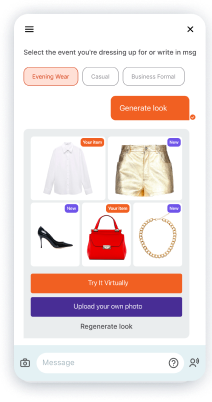In online apparel sales, returns are reaching up to 54%. Such a high rate of returns strains finances and disrupts the stability of companies operating in this sector, as they need to incur extra expenses for recycling returned goods.
Navigating the challenges of apparel merchandise returns is crucial for maintaining financial health and customer satisfaction. By addressing these issues head-on and implementing effective solutions, businesses can forge a path toward greater resilience and success in 2025.
Understanding the primary reasons behind these returns is essential for businesses to navigate this complex landscape effectively.
 Reason 1: Sizing or fit issues
Reason 1: Sizing or fit issues
Sizing or fit issues occur when the purchased garment doesn't match the customer's expectations in terms of size or fit.
Impact on business: Sizing issues lead to customer dissatisfaction, depriving brand reputation and decreasing customer loyalty. It also results in increased return rates, affecting profitability. In the best-case scenario, where the returned item can be resold, the profit margin may decrease by approximately 50%.
Solution: Implementing a comprehensive size guide on product pages, along with customer reviews regarding fit, can help alleviate sizing concerns. Additionally, offering virtual fitting tools like the one worked out by Qlode or personalized size recommendations based on customer data can enhance the shopping experience and reduce return rates.
Reason 2: Product not meeting shopper's expectations
Customers may return apparel if the product received doesn't match their quality, style, or color expectations.
Impact on business: Returns due to unmet expectations result in revenue loss, increased operational costs, and diminished customer trust. It also requires additional resources for restocking and managing returned inventory.
Solution: Providing detailed product descriptions, high-quality images, and customer reviews can help manage expectations and reduce the likelihood of returns. Leveraging augmented reality (AR) technology to allow customers to visualize how the product will look on them can also enhance the shopping experience and minimize returns.
Reason 3: Goods damaged during delivery
Returns may occur when customers receive apparel that has been damaged during the shipping process.
Impact on business: Damaged products during delivery lead to customer dissatisfaction as well as result in increased return rates and additional costs associated with replacing or refunding damaged it.
 Such items can NOT be resold.
Such items can NOT be resold.
Solution: Implementing robust packaging solutions and partnering with reliable shipping carriers can help minimize the risk of products being damaged during delivery. Providing clear instructions for handling and receiving packages can also reduce the likelihood of damage and improve the overall customer experience.
Reason 4: Poor quality
Returns due to poor quality occur when customers receive apparel that doesn't meet their expectations in terms of durability, craftsmanship, or materials.
Impact on business: Returns stemming from poor quality not only result in revenue loss but also damage brand reputation and minimize customer trust. It requires additional resources for quality control and product testing to prevent future returns.
Solution: Providing transparent information about materials and manufacturing processes can also instill confidence in customers and mitigate returns.
Reason 5: Delays in getting items shipped
Returns may occur when customers experience delays in receiving their orders beyond the promised delivery timeframe.
Impact on business: Delays in shipping lead to customer frustration, increased return rates, and negative feedback, affecting brand reputation and customer loyalty. It requires additional efforts to expedite shipping processes and manage customer expectations to prevent future delays.
Solution: Implementing efficient logistics and shipping solutions, such as expedited shipping options and order tracking capabilities, can minimize delays and improve the overall customer experience. Proactively communicating regarding order status and potential delays can also help manage customer expectations and reduce the likelihood of returns due to shipping issues.
Reason 6: Impulse purchases
Impulse purchases occur when customers buy apparel without careful consideration, leading to buyer's remorse. Such items will NEVER be used that contradicts the principles of sustainability.
Impact on business: Impulse purchases often result in higher return rates as customers realize the product doesn't align with their needs or preferences. It also leads to increased administrative efforts and logistics costs associated with processing returns.
Solution: Implementing features such as a ‘pause before purchase’ option or offering personalized recommendations based on previous purchases can help mitigate impulse buying behavior. Providing easy access to customer support and flexible return policies can also encourage customers to feel more confident in their purchases.
Reason 7: Unacceptable customer service
Customers may return apparel due to unsatisfactory customer service experiences, such as delays in response, unhelpful representatives, or lack of support.
Impact on business: Returns resulting from unacceptable customer service reflect poorly on the brand and lead to negative word-of-mouth publicity. It undermines customer loyalty and reduces the likelihood of repeat purchases.
Solution: Investing in comprehensive customer service training for staff and implementing efficient communication channels can improve the overall customer experience. Offering proactive support, such as order tracking and updates, can also enhance customer satisfaction and minimize returns due to dissatisfaction with service.
Drive growth with Qlode by preventing returns!
Effectively managing apparel merchandise returns is crucial for maintaining financial stability and fostering customer satisfaction in the online retail landscape of 2024.
By understanding the key reasons behind returns and implementing targeted solutions to address each underlying cause, businesses can minimize return rates, enhance brand reputation, and drive sustainable growth.
At Qlode, we are committed to helping businesses optimize their return management processes and maximize profitability. Along with traditional methods of minimizing returns, we offer a comprehensive solution for fashion e-commerce.
By integrating Qlode into your online clothing shop, you’ll minimize refunds by at least 31% due to:
Virtual fitting rooms
Qlode offers virtual fitting rooms that allow customers to visualize how garments will look and fit before making a purchase. This reduces the likelihood of returns due to sizing or fit issues.
AI-powered virtual assistant chats
Qlode's AI-powered virtual assistant chats provide personalized assistance to customers, addressing their queries and concerns in real-time. This enhances the shopping experience and reduces returns resulting from unmet expectations or lack of information.
Advanced analytics for personalized outfits
Qlode's advanced analytics capabilities analyze customer preferences and behaviors to offer personalized outfit recommendations. By suggesting items that align with each customer's style and preferences, Qlode minimizes returns due to mismatched expectations or dissatisfaction with product choices.
Integrating Qlode into your online clothing shop not only enhances the overall customer experience but also reduces return rates, leading to improved profitability and customer satisfaction.
Contact us today for a demonstration of our innovative solution and expert consultation on preventing and reducing merchandise returns!


